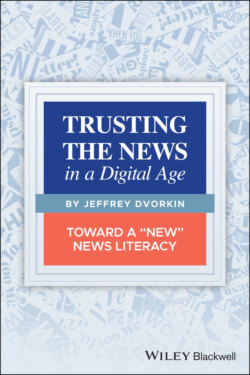Читать книгу Trusting the News in a Digital Age - Jeffrey Dvorkin - Страница 29
The “Uberization” of News
ОглавлениеThere remains some ambivalence about where this all may be going. Media organizations are embracing new technologies, even as journalists see their traditional ranks diminishing. Journalists and journalism schools are teaching new technologies. Marketing is employing new methods of communication and storytelling. But no clear way forward has emerged.
Media managers are privately wondering what went wrong. They are asking why journalism doesn't pay any more. If the solutions are hard to discern, they have only to critically examine the technology they so eagerly embrace.
It's the digital technology. As digital technologies emerged in the late 1990s and early 2000s, it spread throughout many industries, including journalism. Not coincidentally, in media organizations, ratings and circulation began to decline. Media organizations, pressured by shareholders and desperate to find a way to return to bigger profit margins, seized onto digital technology as the silver bullet of transformations. But if ever there was a poison pill, it is digital culture. It has enlarged our possibilities while offering up cat videos, celebrity sightings, and “listicles.” At the same time, a few news organizations (The Guardian and The New York Times) have been able to make investments in online content successful by attracting younger audiences. Most news organizations, however, continue to struggle financially.
Yet media organizations cling to digital news‐making and reporting strategies like a torpedoed sailor clings to a raft, hoping that the next technological submarine won't hit them again.
Clearly we aren't going back to an analog world. Yet, the information needs of the public and the economic requirements of journalism need to intersect. But where? And how? There are no easy answers to these complicated questions…
This changing definition of news can also be connected to the “uberization” of news. Uberization refers to services offered directly and on‐demand through a website or mobile‐app, often (but not always) with the service being provided by an individual or third party who is contracted by the website or app but is not an employee. Some perspectives on these strange times regarding the uberization of news:
We have a lodging system called Airbnb. It doesn't own any actual hotels.
There's a food delivery service called Foodora. It doesn't own any restaurants.
There's a video service called YouTube. It doesn't own movie studios or TV networks. (Like other streaming services, it is also generating original content from freelance producers).
There's a ride‐hailing service called Uber (where the term “uberization” comes from). It doesn't own any cars.
In this so‐called gig economy, where companies are getting rid of costly elements such as staff employees (who receive benefits) and replacing them with freelancers (who receive fewer or no benefits), journalism may also be affected by the increased digitization of information and media institutions. The industries mentioned above – and many others – have been transformed by digital innovation. While customers have benefited from the ease, cost‐effectiveness, and simplicity of digital technology, there is also a powerful downside: wages for workers in affected industries have plummeted, working conditions are often worse, and company morale, in many instances, is dropping and has not yet hit rock bottom.
At the same time, profit margins for owners in many industries have never been greater.
Journalism is also being uberized. There is less reliance on staff reporting and more reliance on content spread by freelancers and platforms such as Facebook and Twitter, resulting in less so‐called enterprise reporting where journalists are given the time and the resources to generate original journalism. As a result, newspapers have closed or been downsized, and broadcasters have cut their more expensive (and usually more labor‐intensive) content. In the rush to return to the once rich profit margins of the early 2000s, media organizations are being urged by their shareholders to dispense with expensive ventures like international reporting. Instead, news consultants are hired to tell their news clients that weather, traffic, and crime (WTC) are what most audiences prefer.
Not coincidentally, WTC also happens to be the cheapest and most readily available content. And all three bits of low‐hanging journalistic fruit happen to originate from government sources. So the issue of how independent journalism is remains in question.
